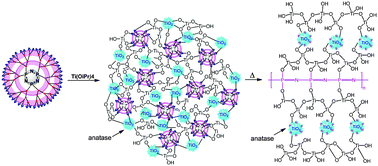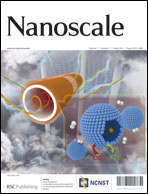The scarcity of low temperature syntheses of anatase nanocrystals prompted us to explore the use of surface-reactive fourth generation phosphorus-dendrimers as molds to control the nucleation and growth of titanium-oxo-species during the sol–gel mineralization process. Unexpectedly, the dendritic medium provides at low temperature, discrete anatase nanocrystals (4.8 to 5.2 nm in size), in marked contrast to the routinely obtained amorphous titanium dioxide phase under standard conditions. Upon thermal treatment, heteroatom migration from the branches to the nanoparticle surface and the ring opening polymerization of the cyclophosphazene core provide stable, interpenetrating mesoporous polyphosphazene–anatase hybrid materials (–P![[double bond, length as m-dash]](https://www.rsc.org/images/entities/char_e001.gif) N–)n–TiO2. The steric hindrance of the dendritic skeleton, the passivation of the anatase surface by heteroatoms and the ring opening of the core limit the crystal growth of anatase to 7.4 nm and prevent, up to 800 °C, the commonly observed anatase-to-rutile phase transformation. Performing this mineralization in the presence of similar surface-reactive but non-dendritic skeletons (referred to as branch-mimicking dendrimers) failed to generate crystalline anatase and to efficiently limit the crystal growth, bringing thus clear evidence of the virtues of phosphorus dendrimers in the design of novel nanostructured materials.
N–)n–TiO2. The steric hindrance of the dendritic skeleton, the passivation of the anatase surface by heteroatoms and the ring opening of the core limit the crystal growth of anatase to 7.4 nm and prevent, up to 800 °C, the commonly observed anatase-to-rutile phase transformation. Performing this mineralization in the presence of similar surface-reactive but non-dendritic skeletons (referred to as branch-mimicking dendrimers) failed to generate crystalline anatase and to efficiently limit the crystal growth, bringing thus clear evidence of the virtues of phosphorus dendrimers in the design of novel nanostructured materials.

You have access to this article
 Please wait while we load your content...
Something went wrong. Try again?
Please wait while we load your content...
Something went wrong. Try again?
![[double bond, length as m-dash]](https://www.rsc.org/images/entities/char_e001.gif) N–)n–TiO2. The steric hindrance of the dendritic skeleton, the passivation of the anatase surface by heteroatoms and the ring opening of the core limit the crystal growth of anatase to 7.4 nm and prevent, up to 800 °C, the commonly observed anatase-to-
N–)n–TiO2. The steric hindrance of the dendritic skeleton, the passivation of the anatase surface by heteroatoms and the ring opening of the core limit the crystal growth of anatase to 7.4 nm and prevent, up to 800 °C, the commonly observed anatase-to-

 Please wait while we load your content...
Please wait while we load your content...